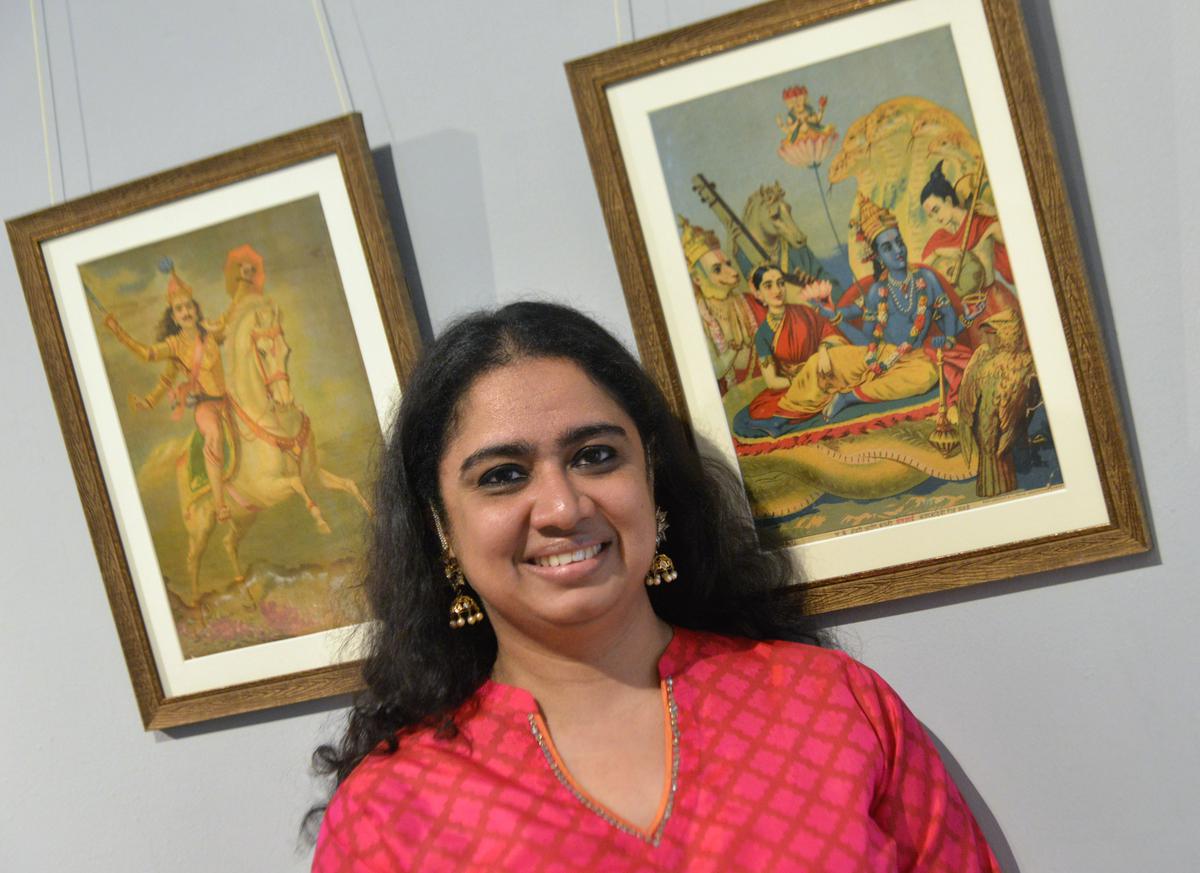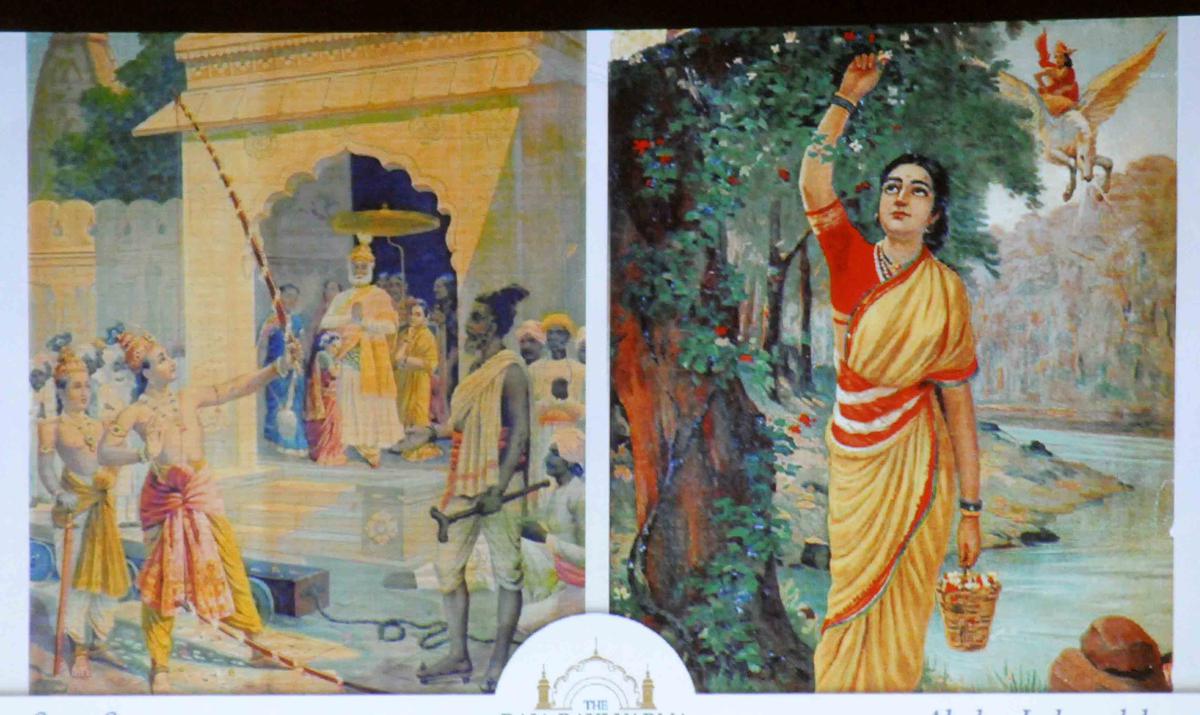Sita, one of the Panchkanya (five women) painted by Raja Ravi Varma, will come alive at the Orientation Hall of Bihar Museum, on April 29, to commemorate the 175th birth anniversary of Raja Ravi Varma.
Organised by Bengaluru-based Raja Ravi Varma Heritage Foundation (RRVHF), the premiere of Sita, a 45-minute monodrama by Anjana Manish Chandak is the fourth in the series.

Gitanjali Maini, CEO, Raja Ravi Varma Heritage Foundation at an earlier exhibition on prints of Raja Ravi Varma’s paintings
| Photo Credit:
BHAGYA PRAKASH
Gitanjali Maini, managing trustee and CEO of the Foundation, says that it is apt that the premiere of Sita takes place in Bihar, because Mithila, as the region was called in ancient texts, is believed to be the birth place of Sita.
Mandodari was the first one to be performed in 2019. Then came Draupadi and Ahalya. After Sita, the series will conclude with Tara in 2024.
The Foundation is also participating in an exhibition ‘Kesh Kala’, an exhibition of paintings on hairstyles, which begins at the museum on May 1. One segment of the exhibition will have a collection of Ravi Varma’s works. Archana Shenoy, curator of the RRVHF, says the Foundation is collaborating with the Bihar Museum for the exhibition. The collection will then travel to Ghent in Belgium for a show.
Founded in 2015 by Princess Bharani Thirunal Rukmini Bayi Thampuran, the great-great-granddaughter of the royal artist and an artist herself, and her son, Jay Varma, also an artist, the Foundation aims to research and study Ravi Varma’s works, disseminate that information and also develop a repository of archival material.
“Till then, there wasn’t a single institution working to preserve, promote and archive the works of the artist. Scholars such as Austrian Erwin Neumayer, Manu S Pillai and Rupika Chawla are on the expert panel of the Foundation to help and advise us,” adds Archana.
The Foundation has already moved ahead with plans to bring out a revised publication of Raja Ravi Varma, Portrait of an Artist: The Diary of C. Raja Raja Varma, which was compiled and edited by Austrian author, anthropologist and research scholar Erwin Neumayer and Christine Schelberger. The work was based on the journal of Raja Raja Varma, younger brother and disciple of Ravi Varma. “It is the absolute timetable and schedule of what the two brothers followed,” says Archana.
“When Neumayer came to India, he compiled all the data he could gather on Ravi Varma. He compiled and edited the book Raja Ravi Varma, Portrait of an Artist: The Diary of C. Raja Raja Varma, which was published by OUP. He was amused by the popular art, many of which were being sold on the road and bought all of those and took it to Austria,” explains Gitanjali.
She points out that later she bought several pieces from Neumayer along with lithographs.
Last year, nine chromolithographs belonging to the RRVHF were loaned to the Louvre Abu Dhabi for a show, Bollywood Superstars: A Short Story of Indian cinema.

Rare painitngs of Raja Ravi Varma displayed at a function organised by the Raja Ravi Varma Heritage Foundation in Coimbatore
| Photo Credit:
PERIASAMY M
The Foundation also organised an exhibition, Revelation and Reverences, at their Bengaluru gallery in December 2022, which continued till March 2023. Archana says that as supporters of the Kochi Biennale, the exhibition was held at around the same time, as many art enthusiasts have a stopover in Bengaluru. It was to enable visitors to have an in-depth look at old Indian masters who had worked in oils. “We held curated walks that took visitors through the 100-year-old evolution of Indian artists working in oils. The focus was on Ravi Varma and some important artists. There were artists who were inspired by him, such as MV Durandhar, Kondiah Raju, GV Venkatesh Rao and so on. It was a huge success going by the footfalls to the gallery,” she adds.
Both Gitanjali and Archana emphasise that they want to take Ravi Varma’s works to new places and people. “We want to bring in new viewers and youngsters and share our knowledge with them,” adds Archana.
The Foundation wants to look at the multiple facets of his legacy and give them a global platform. “Instead of looking at his iconography reverentially, it is also important to study them historically and technically. It was not only the gods that made Ravi Varma popular. He understood legacy management well and he inspired several artists who followed his style and palette. It was they who popularised his style and created a recall factor,” says Gitanjali.
Working with international curators has helped them look at Ravi Varma’s influences and inspirations.
Archana Shenoy, curator of the Bengaluru-based Raja Ravi Varma Heritage Foundation
| Photo Credit:
SPECIAL ARRANGEMENT
“At the Louvre, they were amazed at the information we had on how Ravi Varma had drawn inspiration from European artists such as Manet, Princep, Caravaggio and Raphael. Now, they are working on overdrive on how you can take Ravi Varma to an international audience and draw parallels with their artists,” elaborates Archana.
“The intention of the Foundation is to start working on those levels. How much more are you going to talk about lithographs? How much more are you going to talk about him and that he painted the gods? Look at the other facts historically in his life and times and all the things he has done. For instance, why did he paint portraits? Because the Europeans were painting portraits. He did it brilliantly and documented some amazing people. There are many ways to examine the work he has done, there are other nuances to draw upon, there are other facts to bring to light,” she maintains.
In the short 40-year period, when he was painting, he brought new aesthetics into Indian art. The Foundation has been putting out a lot of literature on the artist, his works and his legacy.
A visitor admires Mohini, a chromolithograph of a Ravi Varma work.
| Photo Credit:
SOMASHEKARA GRN
As Gitanjali points out, once Ravi Varma became popular, there was a great demand for his work and many latter-day artists were told to sign as ‘Ravi Varma’.
“There are a lot of fakes in the market. One step in weeding them out is by talking about what is genuine. The Foundation plays an important role by authenticating a work and finding out if it is an original or a latter-day work,” says Gitanjali.
Since 2016, there has been a surge in the price for an original Ravi Varma and even for chromolithographs and lithographs. Ravi Varma never made a chromolithograph. It was done by another artist. But now, even the price of a chromolithograph has skyrocketed despite it never having seen the hand of the man whose name is used on the chromolithograph. “We have been creating awareness of the artist and his legacy. Do you see how the influence changes the dynamics? Now, an original Ravi Varma sells at ₹38 crore. In 2012, at an auction, one of his paintings went for ₹6.5 lakh. That is how awareness and interest can create new dynamics in the art scene,” says Archana.
Stay connected with us on social media platform for instant update click here to join our Twitter, & Facebook
We are now on Telegram. Click here to join our channel (@TechiUpdate) and stay updated with the latest Technology headlines.
For all the latest Entertainment News Click Here
For the latest news and updates, follow us on Google News.
